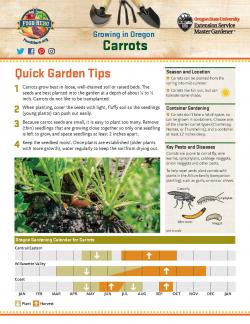Quick Garden Tips
- Carrots grow best in loose, well-drained soil or raised beds. The seeds are best planted into the garden at a depth of about ¼ to ½ inch. Carrots do not like to be transplanted.
- When planting, cover the seeds with light, fluffy soil so the seedlings (young plants) can push out easily.
- Because carrot seeds are small, it is easy to plant too many. Remove (thin) seedlings that are growing close together so only one seedling is left to grow, and space seedlings at least 2 inches apart.
- Keep the seedbed moist. Once plants are established (older plants with more growth), water regularly to keep the soil from drying out.
Season and Location
- Carrots can be planted from the spring into mid-summer
- Carrots like full sun, but can tolerate some shade.
Container Gardening
- Carrots don’t take a lot of space, so can be grown in containers. Choose one of the shorter carrot types (Chantenay, Nantes, or Thumbelina), and a container at least 12 inches deep.
Key Pests and Diseases
- Carrots are prone to carrot fly, wire worms, symphylans, cabbage maggots, onion maggots and other pests.
- To help repel pests plant carrots with plants in the Allium family (companion planting), such as garlic, onions or chives.
When to Plant and Harvest Carrots in Oregon
- Central and Eastern: Plant mid-April to early June to harvest between late June and the end of September.
- Willamette Valley: Plant March through August to harvest June through late November.
- Coast: Plant April through mid-May to harvest mid-May through June. Plant again late June through August to harvest in September.

Recommended Types to Grow by Color
- Orange: Red Core Chantenay, Royal Chantenay, Scarlet Nantes, Bolero, Napa, Danvers
- Yellow: Yellowstone, White, White Satin
- Purple: Purple Haze, Mini, Thumbelina
When and How to Harvest
- Carrots are one of the first and last vegetables to be harvested.
- Most types are ready to harvest when the “shoulder” (the top of the root) is about ½ inch in diameter (wideness), or larger
- Use a trowel or fork to loosen the soil and gently dig up your carrots, which is easier when the soil is damp.
Storage and Cooking
- If stored in a cool spot, carrots will stay fresh for a long time.
- Cut off the green tops and wash and dry the carrots before storing.
- Few other vegetables can match home-grown carrots for vitamin content and sweet flavor. Enjoy them raw with dip, grated into salads, roasted, or cooked and mashed.
- Try this Food Hero recipe: Peach and Carrot Smoothie



